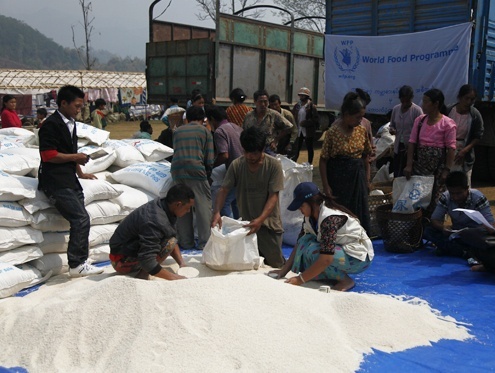The United Nations has been allowed to deliver humanitarian aid to the Kachin rebel headquarters in northern Burma for the first time since December 2011, but a spokesperson warned on Monday that it will not be enough.
A convoy of 11 trucks carrying food, medicines and other essential supplies for 4,300 people arrived in Laiza on Saturday evening, according to the UN Office for the Coordination of Humanitarian Affairs.
But speaking to DVB on Monday, UN spokesperson Aye Win said the aid would only last one month, and that they were still waiting for approval from the Burmese authorities to deliver regular and more substantive supplies.
“We hope to be able to deliver more as soon as possible,” he said. “Obviously [this delivery of aid] is not much given that there are around 53,000 IDPs in non-government controlled areas, and 18,000 around Laiza alone.”
The government has only authorised intermittent convoys of international aid to reach rebel-held camps in northern Burma, where nearly 100,000 people have been displaced since a 17-year ceasefire between the Kachin Independence Organisation (KIO) and the government broke down over two years ago. Local aid workers say malnutrition, water and sanitation-related diseases including dengue, cholera and malaria are rife.
“We are pleased that this much needed humanitarian assistance to the IDPs has been permitted. I hope that unhindered access to all the IDPs will be permitted by all sides under humanitarian principles,” said UN Resident and Humanitarian Coordinator Ashok Nigam.
In June, a convoy reached Mai Ja Yang, another rebel-held border town southeast of Laiza, but nothing has been let through since. IDPs are forced to rely on the limited assistance provided by local organisations, the KIO and church groups.
“UN aid only came once and then they disappeared,” Hkaw Lwi from the Mai Ja Yang-based aid group, Wunpawng Ning Htoi, told DVB on Monday. “It would be very good if they could support [us] as they promised – they said that they would come again next month so the local NGOs didn’t prepare for that month – and then they didn’t come.”
Hkaw Lwi is sceptical that the government will let regular UN convoys into KIO territories, including Laiza, where local aid groups are swiftly haemorrhaging funding. “[Only] the local organisations are supporting the IDPs and it is not secure in terms of food,” she said. “The organisations only have funding for three months, six months at most.”
Even though the KIO signed a preliminary ceasefire with the government in May, ongoing clashes have been reported throughout the restive state, as well as in neighbouring northern Shan state. Many locals are deeply suspicious about the government’s motives and fear that a durable ceasefire is nowhere in sight.
The KIO fought the former military dictatorship for greater autonomy and ethnic rights for several decades before signing a ceasefire in 1994, which collapsed in June 2011 when the rebels refused to transform into a state-controlled border guard force.
President Thein Sein has secured ceasefire deals with ten out of 11 major ethnic armed groups since taking office, but the KIO is adamant that only a political solution will resolve the crisis.
The conflict reached its peak between December 2012 and February 2013, when the Burmese army besieged Laiza using a series of coordinated land and air strikes.
The UN has repeatedly called for a “durable solution” to the Kachin conflict. “Ideally, IDPs should be able to return home to their livelihoods and humanitarian aid would be unnecessary,” said Aye Win.



